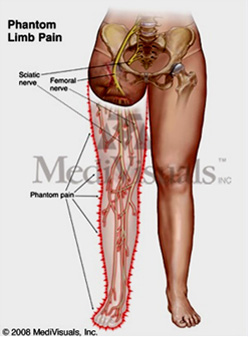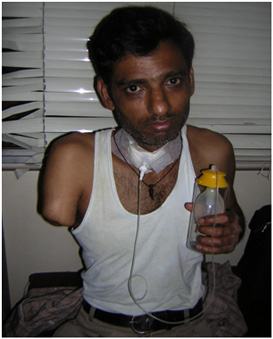 Phantom limb pain refers to painful sensations that seem to be coming from the part of the limb that is no longer there. The limb is gone but the pain is real. The onset of this pain most often occurs soon after surgery
Phantom limb pain refers to painful sensations that seem to be coming from the part of the limb that is no longer there. The limb is gone but the pain is real. The onset of this pain most often occurs soon after surgery
Phantom limb pain is usually intermittent. The frequency and intensity of attacks usually declines with time
Phantom limb sensations occur roughly in 85% of amputees and tend to be seen in the first 3 weeks after amputation. Most phantom sensations generally resolve without treatment after 2 to 3 years
Residual limb pain—previously referred to in the literature as stump pain—refers to a regional pain restricted to the distal residual part. Unlike phantom pain, it occurs in the area of the body that actually exists. Patients may also experience feelings of tingling, itching, cramping, or involuntary movements in the residuum
Phantom pain may be modulated by multiple factors, both internal as well as external. Exacerbations of pain may be produced by physical or emotion stimuli. Anxiety, depression, urination, cough, defecation, sexual activity, cold environment, or changes in the weather may worsen Phantom limb pain.
PHARMACOLOGIC INTERVENTIONS
Antidepressants
Antiepileptic Drugs
Opioids
NMDA Receptor Antagonists (ketamine infusion)
 Interventional Therapy
Interventional Therapy
A wide variety of types of neural blockade have been utilized in the treatment of Phantom limb pain, including trigger point injections, sympathetic blocks, stump injections, peripheral nerve blocks, epidural and subarachnoid blocks
Continuous Stellate Ganglion Block
Neuromodulation
Transcutaneous electrical nerve stimulation has been used with some success in the treatment of phantom pain.
Spinal cord stimulation (SCS) has also been used for PLP